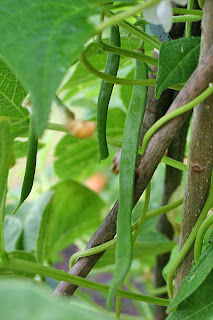I chased it away repeatedly, its resemblance to a wasp making me afraid to kill it with my bare hands, even though I knew it could not hurt me. Finally, after the moth left for good, I returned inside to read a little about eradicating these bugs from my garden. Armed with photos, a bit of knowledge, a box cutter, and a pair of tweezers, I went back to the side garden ready to do battle to save my plants. I do not really mind if the borers get the zucchini, since I doubt those plants will produce any fruit this year, but I definitely do not want to lose my pumpkins or my butternut squash. I had read that the butternut is resistant to the vine borers, but that pumpkins are very susceptible to being damaged by them.
When I reached the garden, I began examining the base of each vine. I plucked a few eggs from one of the summer squash, but I could not find any on the other plants. Then, I noticed what I had hoped I would not find - a small hole near the base of my only healthy pumpkin vine. I debated whether I should operate on the plant and risk killing it if I were wrong, but I decided that leaving a vine borer inside the plant would be worse than cutting it open a bit. I carefully sliced open the vine, beginning at the hole, and removed a fat, squirming vine borer from the stem.
 I checked a little further down and could not find any more of the caterpillars. I shoveled a few scoops of damp soil over the cut stem and over a few of the leaf joints on the vine, where I knew the plant had been putting down auxiliary roots. Hopefully, the plant will survive the surgery, since I caught the bug before any damage had occurred.
I checked a little further down and could not find any more of the caterpillars. I shoveled a few scoops of damp soil over the cut stem and over a few of the leaf joints on the vine, where I knew the plant had been putting down auxiliary roots. Hopefully, the plant will survive the surgery, since I caught the bug before any damage had occurred.Next, I examined the other squash plants in my garden and removed a smaller borer from a zucchini plant. The rest of the plants appeared to be okay.
When Hannah came downstairs from her quiet time in her room, I showed her the picture I took of the squash vine borers, and I brought her outside to look at the plants. I explained that just one tiny caterpillar could kill an entire plant. Together, we checked, but could not find any more of the "bad bugs" as Hannah called them.
After we returned to the house, I pulled out my Bible and read Genesis 3:17-19:
"To Adam he said, "Because you listened to your wife and ate from the tree about which I commanded you, 'You must not eat of it,' Cursed is the ground because of you; through painful toil you will eat of it all the days of your life. It will produce thorns and thistles for you, and you will eat the plants of the field. By the sweat of your brow you will eat your food until you return to the ground, since from it you were taken; for dust you are and to dust you will return."
I shared with Hannah that bugs and weeds and powdery mildew and other garden ailments are all part of the curse, the punishment put on the earth because of the Fall. I explained that our sin has caused the difficulties we have in producing food from the land, but that God still blesses us and allows us to eat the fruit of our labor. And, He often gives us an abundance, well more than we need, though it does not come without effort. Furthermore, we can rejoice in the good news that we are redeemed and sin no longer defines us. Instead, we have hope for a future "in heaven, where moth and rust do not destroy, and where thieves do not break in and steal" (Matthew 6:20). And that is the Good News we can learn from "bad bugs."















